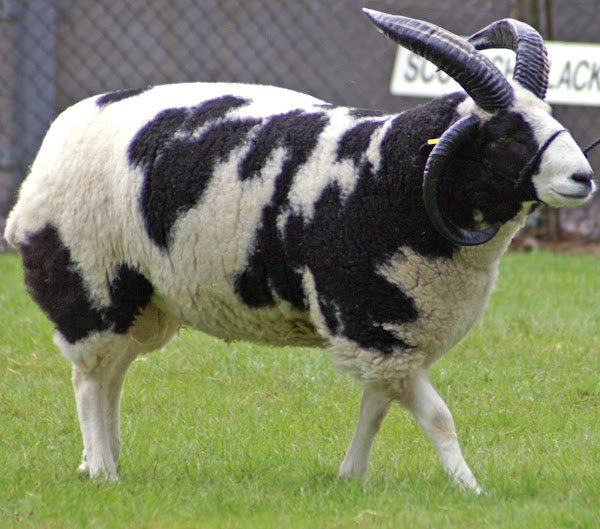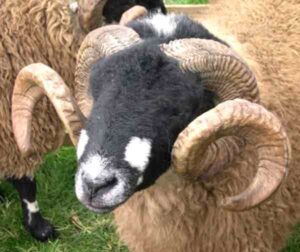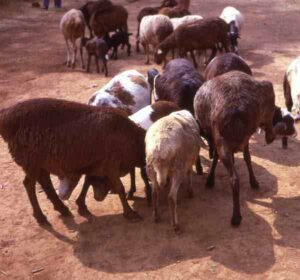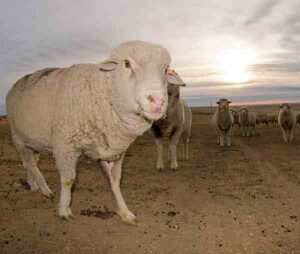The Jacob sheep is a breed of domestic sheep from Middle East. Exact origins of this breed is still unclear, but it is certainly a very old breed.
It has probably descended from an ancient Old World sheep breed. Sheep with spots have been described in many cultures throughout history, appearing in works of art from the Far East, Meddle East and Mediterranean regions.
They were documented in England by the 1600s and were widespread by the mid-1700s.
The Jacob sheep is actually a piedbald and multi-horned (polycerete) animal. It is also known by some other names such as Many-horned sheep, Piebald sheep and Spanish sheep.
And the breed is named for the Biblical figure of Jacob. It became popular in England as ornamental, or ‘park’ sheep. During the beginning of the mid-1900s, this breed was first imported into North America.
And most of the today’s population descends from imports of the past 30 years.
The Jacob sheep was very popular among the small flock holders as well as hand spinners and weavers.
The North American sheep breeders have selected this breed primarily for fleece characteristics, and the conformation of the sheep has remained very much like it’s historical description.
However, today the breed is pretty rare, and The American Livestock Breeds Conservancy has listed the North American population of Jacob sheep as a conservation priority.
But the Rare Breeds Survival Trust (RBST) in the United Kingdom, do not consider the Jacob as being at risk as there are more than 3,000 registered breeding ewes available.
Today, there are many breed registries for this breed, whose only focus in the Jacob sheep. Two notable registries are; the Jacob Sheep Breeders Association, and the American Jacob Sheep Registry. However, read some more information about this breed below.
Jacob Sheep Characteristics
The Jacob sheep are a medium-sized, piebald and multi-horned sheep that resembles a goat in it’s conformation. They may have from 2 to 6 horns, but most commonly have four.
However, the Jacob sheep is not the only breed that can produce polycerate or piebald offspring.

Other piebald sheep breeds include the Finnsheep and the West African Dwarf, and other polycerate sheep breeds include the Manx Loaghtan, Navajo-Churro, Hebridean and Icelandic sheep.
Common coloration of the Jacob sheep is black and white. They have long body frame, with a straight back and a rump that slopes toward the base of the tail.
The ewes have small udders free of wool that are held closer to the body than those of the modern sheep breeds. While the rams have short scrotums, which are free of wool and hold the testicles closer to the body than those of other modern breeds.
Head of the Jacob sheep is slender and triangular. And the head is clear of wool forward of the horns and on the cheeks.
Tail of these animals is long and woolly, extending almost to the hock if it has not been docked. Their legs are of medium-length, slender, preferably white in color with or without colored patches and the legs are free of wool below the knees.

As a medium-sized animal, average live body weight of the mature Jacob ewes is between 36 and 54 kg. And live body weight of the mature rams vary from 54 to 82 kg. Photo and info from Wikipedia.
Uses
The Jacob sheep are multi-purpose animals. They are generally raised for their meat, wool and hides. But they are also raised as pets or kept for ornamental purpose.
Special Notes
The Jacob sheep are very hardy and strong animals with docile temperament. They are multi-purpose animals and used for many different purposes. They produce good quality meat and a medium quality fleece.
Their fleece is light and open with a staple length of 4-6 inches. Quality of the fleece has been a major selection factor in the recent history of the Jacob sheep breed, unlike most other medium wool sheep breeds.
The Jacob ewes are excellent mothers, and they bear 1 or 2 lambs in the spring only. The lambing is usually very easy for them. Along with raising for meat, wool and hides, the breed is also very good for raising as pets or for ornamental purpose.
They also have been used as a guard animal for protecting farm and property from theft or vandalism and defend other livestock against predators.
Along with being very hardy, the Jacob sheep are also low-maintenance animals. They are strong animals with a naturally high resistance to parasites and hoof problems.
But these animals do not show much flocking behavior. They will require shelter from extreme temperatures. Although, open and simple shelter will be good for them.
They are excellent foragers, and they can secure adequate nutrition with minimal to no supplementation (even in the presence of suboptimal soil conditions. However, review full breed profile of the Jacob sheep in the following chart.
| Breed Name | Jacob |
| Other Name | Also known by some other names such as Many-horned sheep, Piebald sheep and Spanish sheep. |
| Breed Purpose | Meat, wool, hides, pets, ornamental |
| Special Notes | Very hardy and strong animals,docile temperament, multi-purpose animals, good for meat production, good for wool, good for hides, good for raising as pets, good for ornamental purpose, good for raising as guard animals, ewes are good mothers and they have little or no lambing problems, low-maintenance animals, resistance to parasites and hoof problems, can tolerate extreme temperatures |
| Breed Size | Medium |
| Weight | Rams weight between 54 and 82 kg, and mature ewes body weight vary from 36 to 54 kg |
| Horns | Yes |
| Climate Tolerance | Different climates |
| Color | Black and white |
| Rarity | Common |
| Country/Place of Origin | Middle East |






